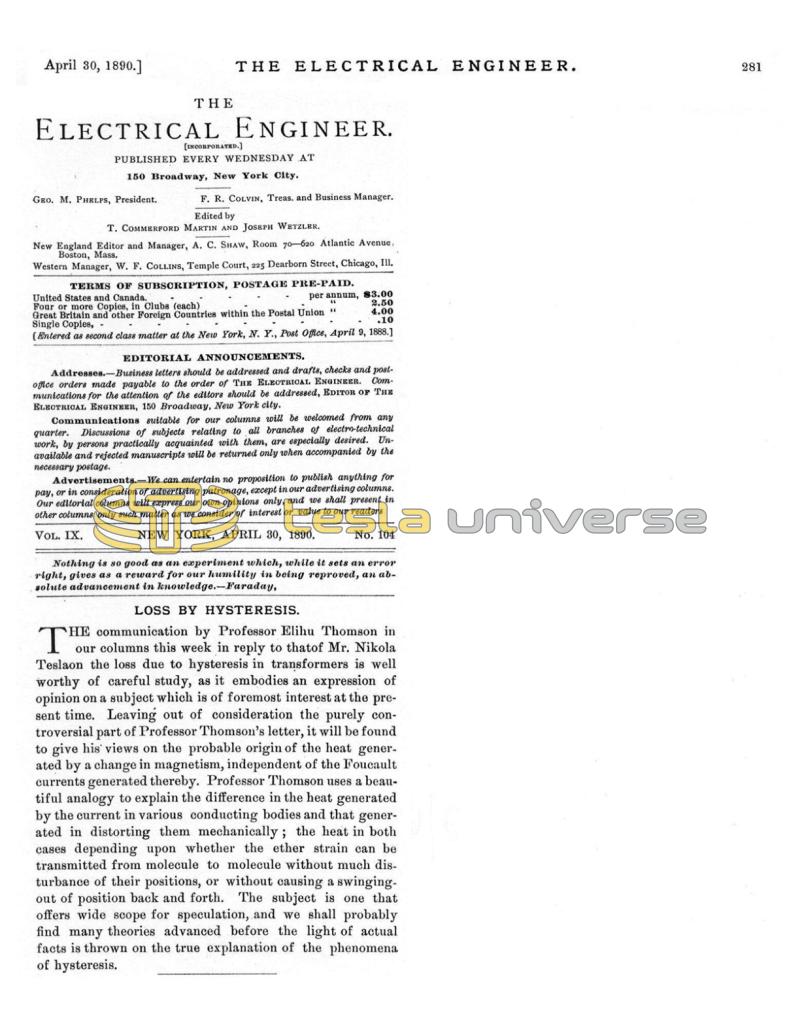
Nikola Tesla Articles
Loss by Hysteresis - A reply to Nikola Tesla by Elihu Thomson
The communication by Professor Elihu Thomson in our columns this week in reply to that of Mr. Nikola Tesla on the loss due to hysteresis in transformers is well worthy of careful study, as it embodies an expression of opinion on a subject which is of foremost interest at the present time. Leaving out of consideration the purely controversial part of Professor Thomson’s letter, it will be found to give his views on the probable origin of the heat generated by a change in magnetism, independent of the Foucault currents generated thereby. Professor Thomson uses a beautiful analogy to explain the difference in the heat generated by the current in various conducting bodies and that generated in distorting them mechanically; the heat in both cases depending upon whether the ether strain can be transmitted from molecule to molecule without much disturbance of their positions, or without causing a swinging-out of position back and forth. The subject is one that offers wide scope for speculation, and we shall probably find many theories advanced before the light of actual facts is thrown on the true explanation of the phenomena of hysteresis.
Loss by Hysteresis
[124] - In his letter (121) appearing in your issue of April 9, page 221, Mr. N. Tesla in discussing the losses due to hysteresis in transformers takes the ground that such losses outside of the generation of electrical currents, or independent thereof, are “difficult to reconcile with our present notions on the constitution of matter generally.” Further on he says: “We cannot imagine that an appreciable amount of energy should be wasted by the elastically connected molecules swinging back and forth from their original position,” etc. While I agree with Mr. Tesla that the actual loss referred to may be due to molecular currents, yet we have no proof of such fact. Again Mr. Tesla seems to forget that loss, waste, and such terms, are more scientifically rendered, by the words “conversion into heat," and that in nature nothing is wasted or lost, but merely converted.
Now we may consistently amend his quoted statement as follows, and see how it reads: “We cannot imagine that an appreciable amount of energy should be converted into heat by the elastically connected molecules swinging back and forth from their original positions,” etc.
Heat action is that swinging back and forth referred to, namely, “molecular vibration,” and if we find that such swinging takes place we must have heat as a result. When the molecules can polarize or turn without being given a swinging movement or vibration, no conversion into heat takes place. The difference then between very soft iron and hard steel so far as magnetic waste goes, is, apparently, that in the soft iron there is less disturbance of position of the molecules during magnetization and reversal than in steel, assuming the degree of magnetization or polarization to be equal in each. The waste or conversion due to electrical resistance is of the same nature. Whenever the ether strain can be transmitted from molecule to molecule of the conductor without much disturbance of their positions or without causing a swinging out of position back and forth, the conductivity is great and the reverse is true with bad conductors.
In like manner, bending a bar of tempered steel back and forth within limits is mechanically efficient because very little conversion of motion into heat takes place, and this is a result of the relative positions of the molecules being preserved; while, bending a bar of inelastic metal, as a copper rod of moderate hardness, produces heat by disturbance and swinging of molecules. Such bending is inefficient.
There is then to my mind no more difficulty in understanding that a conversion into heat may be produced magnetically than electrically, or mechanically. Indeed, if, as seems probable, these actions are but variations of ether strain phenomena they are reducible to a single effect, and represent the molecular disturbances produced by transmission of ether strains. Cohesion, gravitation and forces acting between molecules, must of course be recognized as results of ether strains.
Molecules themselves, or matter itself, may be resolvable into ether movements or vortices, and we may be able to put “energy indestructible” in place of “matter indestructible” and mean as much. We need to forget the universe as made up of pieces, entities or particles, put together and allowed to interact and react, and learn to regard it as a consistent whole from which nothing can be taken without disturbing the balance or equilibrium of what remains. It is in my view more legitimate to attribute the heating effects of Foucault currents and other currents to a general molecular friction or hysteresis of conduction, if we may use such a term, than to assume the production of molecular currents in the heating or conversion of magnetic hysteresis. We have no present need of currents in accounting for heat conversion of mechanical friction and molecular friction of inelastic bodies when bent or distorted by mechanical force. Neither can we deny that theoretically such conversion into heat may be accompanied by molecular electric currents similar to eddy currents or Foucault currents, but infinitely more restricted as to length of circuit. On these points and others of equal interest we may speculate, but are in need of more facts to confirm our speculations.
ELIHU THOMSON.
LYNN, MASS.
